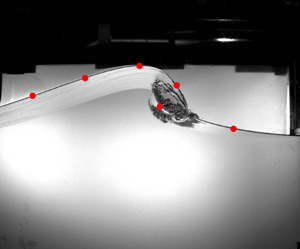Crossref Citations
This article has been cited by the following publications. This list is generated based on data provided by
Crossref.
Pizzo, Nick
Murray, Ethan
Smith, David Llewellyn
and
Lenain, Luc
2021.
The role of bandwidth in setting the breaking slope threshold of deep-water focusing wave packets.
Physics of Fluids,
Vol. 33,
Issue. 11,
VreĆica, Teodor
Pizzo, Nick
and
Lenain, Luc
2022.
Observations of Strongly Modulated Surface Wave and Wave Breaking Statistics at a Submesoscale Front.
Journal of Physical Oceanography,
Vol. 52,
Issue. 2,
p.
289.
Ruth, Daniel J.
Néel, Baptiste
Erinin, Martin A.
Mazzatenta, Megan
Jaquette, Robert
Veron, Fabrice
and
Deike, Luc
2022.
Three‐Dimensional Measurements of Air Entrainment and Enhanced Bubble Transport During Wave Breaking.
Geophysical Research Letters,
Vol. 49,
Issue. 16,
Karabut, E.A.
Zhuravleva, E.N.
Zubarev, N.M.
and
Zubareva, O.V.
2022.
Evolution of nonlinear perturbations for a fluid flow with a free boundary. Exact results.
Journal of Fluid Mechanics,
Vol. 953,
Issue. ,
Eeltink, D.
Calvert, R.
Swagemakers, J.E.
Xiao, Qian
and
van den Bremer, T.S.
2023.
Stochastic particle transport by deep-water irregular breaking waves.
Journal of Fluid Mechanics,
Vol. 971,
Issue. ,
Govindasamy, Vijaya Kumar
Chella, Mayilvahanan Alagan
Sannasi Annamalaisamy, Sannasiraj
and
Rajamanickam, Panneer Selvam
2023.
Impact pressure distribution and characteristics of breaking wave impact on a monopile.
Ocean Engineering,
Vol. 271,
Issue. ,
p.
113771.
Cao, Rui
Padilla, E.M.
and
Callaghan, A.H.
2023.
The influence of bandwidth on the energetics of intermediate to deep water laboratory breaking waves.
Journal of Fluid Mechanics,
Vol. 971,
Issue. ,
McAllister, M.L.
Pizzo, N.
Draycott, S.
and
van den Bremer, T.S.
2023.
The influence of spectral bandwidth and shape on deep-water wave breaking onset.
Journal of Fluid Mechanics,
Vol. 974,
Issue. ,
Boswell, Hunter
Yan, Guirong
and
Mostert, Wouter
2023.
Characterizing energy dissipation of shallow-water wave breaking in a storm surge.
Physical Review Fluids,
Vol. 8,
Issue. 5,
Calvert, R.
Peytavin, A.
Pham, Y.
Duhamel, A.
van der Zanden, J.
van Essen, S. M.
Sainte‐Rose, B.
and
van den Bremer, T. S.
2024.
A Laboratory Study of the Effects of Size, Density, and Shape on the Wave‐Induced Transport of Floating Marine Litter.
Journal of Geophysical Research: Oceans,
Vol. 129,
Issue. 7,
Callaghan, A. H.
Deane, G. B.
and
Stokes, M. Dale
2024.
A Comparison of Laboratory and Field Measurements of Whitecap Foam Evolution From Breaking Waves.
Journal of Geophysical Research: Oceans,
Vol. 129,
Issue. 1,
Xiao, Q.
McAllister, M.L.
Adcock, T.A.A.
and
van den Bremer, T.S.
2025.
Laboratory study of the enhanced wave-induced drift of large rectangular floating objects.
Journal of Fluid Mechanics,
Vol. 1008,
Issue. ,
Callaghan, Adrian H.
2025.
Estimates of the Breaking Strength Parameter for Individual Oceanic Whitecaps.
Geophysical Research Letters,
Vol. 52,
Issue. 18,
Xiao, Qian
Yan, Shiqiang
Adcock, Thomas A.A.
and
van den Bremer, Ton S.
2025.
The effects of vorticity and turbulence on the wave-induced drift of bluff bodies in numerical simulations.
Applied Ocean Research,
Vol. 161,
Issue. ,
p.
104645.

 $\varDelta$. This extends the work of Deike et al. (J. Fluid Mech., vol. 829, 2017, pp. 364–391) and Lenain et al. (J. Fluid Mech., vol. 876, 2019, p. R1), where similar numerical and laboratory experiments were conducted, but the bandwidth was held constant. In this paper, it is shown that the transport is strongly affected by the bandwidth. A model for the horizontal length scale of the breaking region is proposed that incorporates the bandwidth, central frequency, the linear prediction of the slope at focusing and the breaking threshold slope of the wave packet. This is then evaluated with data from archived and new laboratory experiments, and agreement is found. Furthermore, the horizontal length scale of the breaking region implies modifications to the model of the energy dissipation rate from Drazen et al. (J. Fluid Mech., vol. 611, 2008, pp. 307–332). This modification accounts for differing trends in the dissipation rate caused by the bandwidth in the available laboratory data.
$\varDelta$. This extends the work of Deike et al. (J. Fluid Mech., vol. 829, 2017, pp. 364–391) and Lenain et al. (J. Fluid Mech., vol. 876, 2019, p. R1), where similar numerical and laboratory experiments were conducted, but the bandwidth was held constant. In this paper, it is shown that the transport is strongly affected by the bandwidth. A model for the horizontal length scale of the breaking region is proposed that incorporates the bandwidth, central frequency, the linear prediction of the slope at focusing and the breaking threshold slope of the wave packet. This is then evaluated with data from archived and new laboratory experiments, and agreement is found. Furthermore, the horizontal length scale of the breaking region implies modifications to the model of the energy dissipation rate from Drazen et al. (J. Fluid Mech., vol. 611, 2008, pp. 307–332). This modification accounts for differing trends in the dissipation rate caused by the bandwidth in the available laboratory data.

